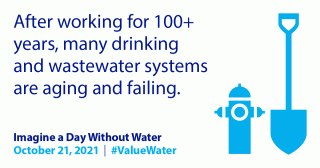This year, as everyone comes together on October 21 to Imagine a Day Without Water, it is important to remember the vital importance of our nation’s infrastructure in providing us with clean and safe water. More than 2 million miles of underground pipes provide millions of people with safe drinking water. Wastewater infrastructure, including more than 800,000 miles of sewer pipes, collect waste from homes, businesses, and industrial sites throughout the country in order to protect the environment and safeguard public health. According to the U.S. Geological Survey, 39 billion gallons of water are used by the public every day.
Unfortunately, this vital infrastructure is in critical need of investment, repair, and revitalization. More than 16,000 wastewater treatment plants throughout the country currently function at 81 percent of their design capacity, and 15 percent have reached or exceeded that capacity. Drinking water systems are rapidly aging. It is estimated that there is a water main break in the United States every two minutes, and an estimated 6 billion gallons of treated water lost every day.
Federal funding for drinking water infrastructure has failed to keep up with the needs of aging water infrastructure. By 2029, it is estimated that the gap between drinking and wastewater infrastructure investment and funding needs will reach more than $430 billion. In its 2021 Infrastructure Report Card, ASCE gave our nation’s drinking water and wastewater infrastructure grades of C- and D+ respectively. We are at a moment where bold action is needed to strengthen our nation’s water infrastructure, and ensure that all Americans have access to clean and functioning drinking water and water systems.

That is why legislative action like the landmark Infrastructure Investment and Jobs Act is so critical. The IIJA invests $55 billion for upgrades to water infrastructure. This includes $43 billion to reauthorize the Clean Water State Revolving Fund and Drinking Water State Revolving Fund, $15 billion to replace lead service lines, and $280 million annually for sanitary sewer overflows and stormwater reuse grants. It will also invest $75 million annually for research to help support water treatment center training and to address water pollution.
As you participate in this year’s Imagine a Day Without Water, it remains important to remember everything that goes into providing everyone with safe water to drink and effective water treatment systems. They are vital, and in need of upkeep and modernization. But while our nation’s water infrastructure is in need of significant investment, a day without water is not a foregone conclusion. Let’s continue to do the work needed to ensure we all have access to clean water.









